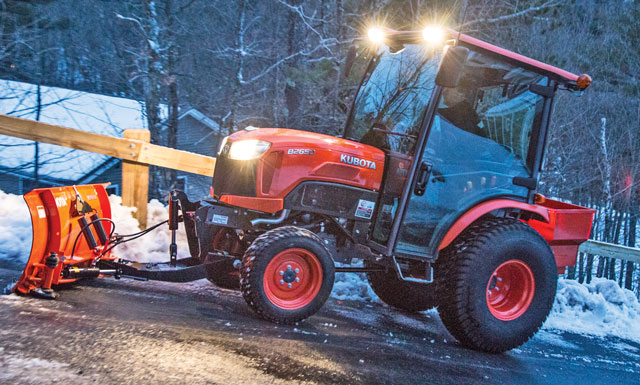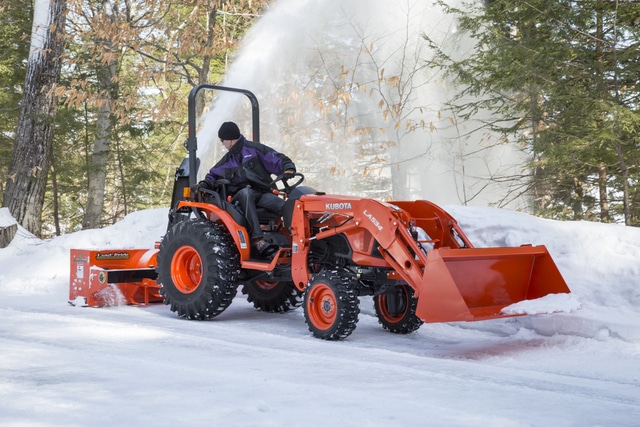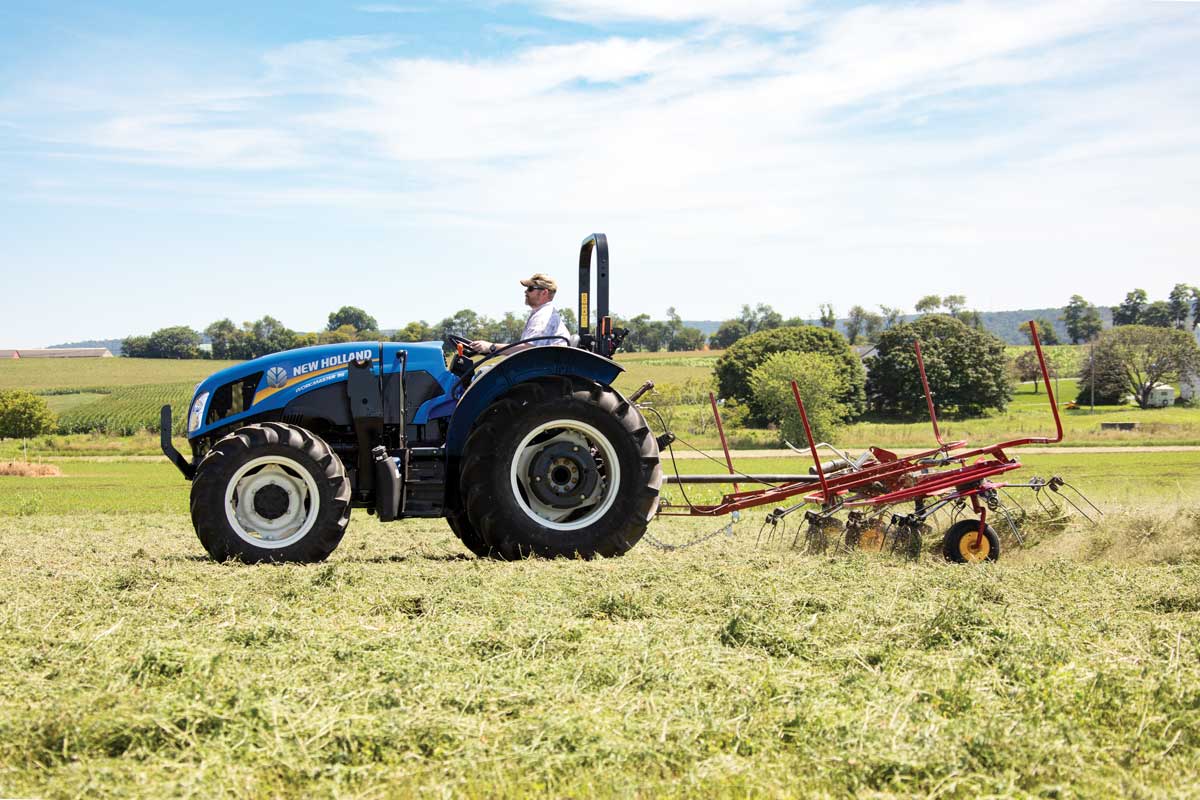Get Snow Ready: Prepare and Maintain Your Compact Tractor for Work During the Winter Months

Kubota B2650 Series with a front hitch and blade helps to keep the road clear.
Fall is in the air, and snow is undoubtedly on its way in many parts of the country. Whether you’re planning to use your compact tractor to work in the elements or store it away for the winter months, October is the ideal month to prep and plan accordingly. Fall, or what I like to call “pre-season,” is critical, and I’m not talking football. If you live in an area that reaches freezing temperatures and you plan to use your compact tractor in the snow, ice and sleet, it’s important to properly set up your tractor for its new terrain and tasks. In fact, mark your calendar every October as this is a maintenance list that should become an annual practice.
Before the Snow Flies, Do This
Many compact tractors are designed to be versatile year-round, and when outfitted with attachments such as snow blowers and blades they can be the perfect tool for snow management. However, before the first snow flurry, it’s important to run through a series of cold-weather checks and procedures for preparing both compact tractors and implements for cold winter jobs.
First and foremost, follow the operator’s manual for winterizing your tractor. This may seem like a mundane piece of advice, but even the seasoned operator will often learn tips, maintenance schedules and new information by reading the owner’s manual. Even models from the same manufacturer might differ slightly based on the year it was produced. All of this good information is in the manual for easy reference.
Setting Up Your Compact Tractor for Snow
The top priority when preparing your tractor for the winter is to check fluids; this includes checking, refilling and replacing fluids as needed. Again, this is a critical annual check to maintain your equipment, and October is the optimal month to do so being that its right before the weather gets colder. Be sure to check the condition of your coolant and make sure it is has the proper mix to prevent freezing. If you wait for the temperatures to drop and the mix is incorrect it could lead costly repairs and downtime. If you haven’t replaced your coolant in three years do that as well. Owners should keep a record of their maintenance so you know exactly when the last time each fluid and filter was changed. It’s amazing how quickly three years can sneak up on you. In addition to fluids, here are other checks for this month:
- Grease the tractor at all grease points. It is also a good idea to apply a light coat of grease to all exposed cylinder rods to help prevent corrosion. The elements get a little more extreme in the winter and greasing will help protect the machine.
- Verify that your battery is in good working condition.
- Make sure your fuel is winterized before the cold weather begins.
- Check your tires. This includes checking for proper tread depth, proper inflation and making sure there is no tire damage. Also, check the wheel lug nuts for proper tightness.
- Check that all lights are functioning properly. Days are rapidly getting shorter and you’ll rely on these lights more in the winter.
- Check all safety devices such as ROPS to make sure they are in place and secured properly. If you are not storing the compact tractor, do not fold or remove the ROPS.
- Install any hitches or other devices that may be needed to attach snow removal equipment.
- Check all hydraulic hoses for damage or leaks.
- Verify that your air filter for your engine (and your cab, if equipped) is clean and free from damage.
Preparing Implements for Snow Work
Snow work is fun. It means bringing out the snow blowers, blades and sweepers. Again, because each piece of equipment is different, it’s important to follow the operator’s manual for implement maintenance. Before the first snow, it’s critical to verify that your snow implements attach to your tractor and function properly. Think of it as a practice run. You don’t want to run into problems when you have a job to do, it’s 15 below and dumping snow. Avoid that scenario and make for comfortable snow work by checking and actually attaching all implements before that first snow dusting. Here are a few other implement checks:
- Grease all implement grease points and apply a light coat of grease to all exposed cylinders and latch points.
- Check the u-joints in all drive lines.
- Check any wear item (such as replaceable cutting edges) to verify they are in good working condition and do not need to be replaced.
- Check and add or replace the fluid in gear boxes.
- Check all hydraulic hoses for damage or leaks, and verify that all hydraulic couplers are functioning properly.
Bring on the White Stuff
Once you have done your pre-season check, you are officially snow-ready. While operating a compact tractor in the winter months it is important to practice a regular maintenance routine. Because weather is unpredictable and can quickly escalate into more extreme work conditions, I like to advise operators to use downtime wisely — continuously check the condition of your equipment throughout the winter and complete all repairs and maintenance items as soon as possible. Don’t wait for things to get worse on the tractor because you could find yourself in an urgent situation in the middle of a snowstorm, literally. No matter what time of year, it’s important to clean the unit after each use, keep the unit greased and maintain your battery charge. You can maintain a battery charge by making sure you start and run the equipment on a regular basis (every other day) or by using a “trickle” charger designed for this type of application.

Putting your compact tractor into hibernation for the winter? While compact tractors shine in snow work, there are some fleets that might need to put a unit into storage for the winter months. Instead of prepping for work in freezing temperatures, the goal becomes prepping for long-term non-use and ultimately setting the tractor up for an easy start after the snow melts. For long-term cold-weather storage, the industry generally recommends conducting a full service before storing, which includes all of the regular maintenance procedures above like greasing, checking the tires, lights, hoses and filters. In addition, here are a few long-term storage tips:
- Change your engine oil before storage BUT make sure to run your tractor for at least 10 minutes after your oil change (to circulate the oil) before putting it into long-term storage.
- If your tractor has a clutch pedal lock to release the pressure (lock the clutch pedal in the “pressed” position), engage and lock your brakes and then engage the clutch pedal lock once the unit is in storage. This will help prevent the pressure plate from seizing up and also help prevent the clutch plate from sticking to the flywheel or pressure plate.
- Verify that your battery is in good working condition and prepare it for long-term storage. This can mean either removing the battery and storing it or using a trickle charger designed for storage applications.
- If you fold or move the ROPS for storage, be sure that it is back in place and secured properly before starting the tractor again.
The change of seasons is an exciting time. In the world of equipment, it means new tasks and implements to bring into action. If you prep for and winterize your compact tractor, it will help keep you productive and efficient through the winter months … even as you’re enjoying your snow blowing “job” in a balmy 75-degree cab. That’s what owning a compact tractor is all about.
Robert Cockroft is the senior Kubota product manager for sub- and compact tractors.




